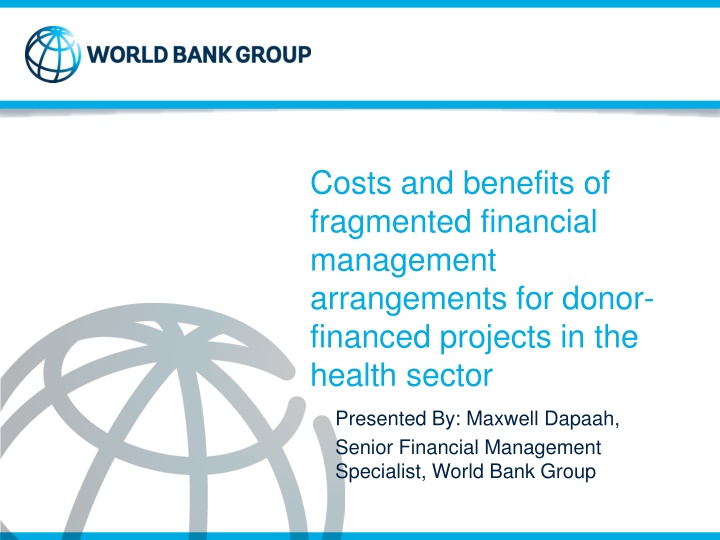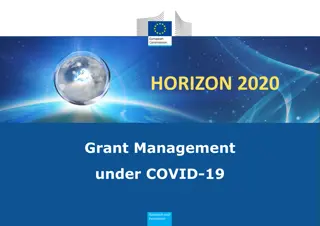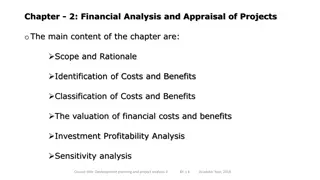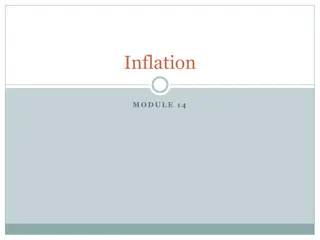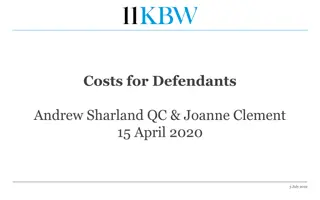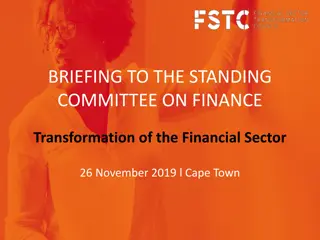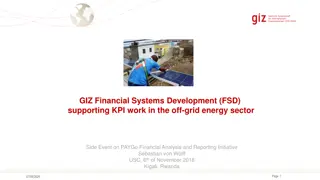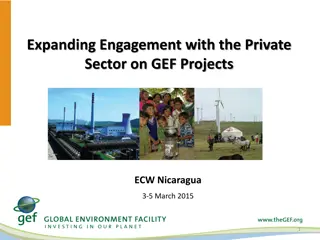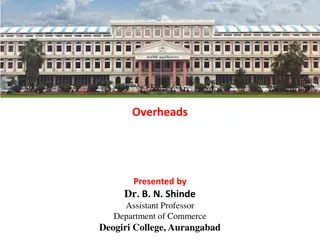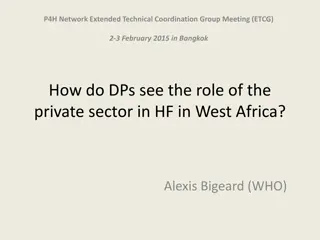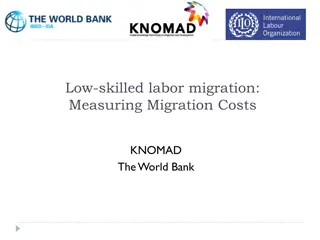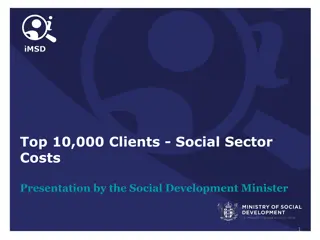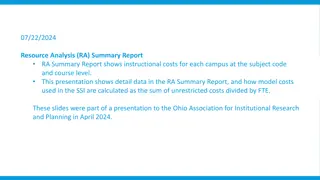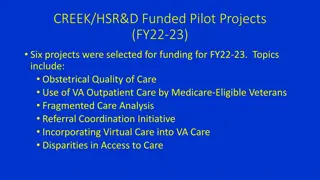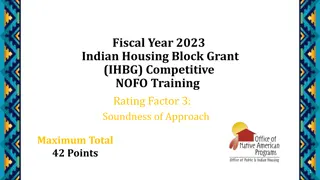Costs and Benefits of Fragmented Financial Management in Health Sector Projects
The study explores the costs and benefits of fragmented financial management arrangements for donor-financed projects in the health sector. It emphasizes the importance of open and orderly Public Financial Management (PFM) systems in achieving desirable outcomes and discusses strategies to minimize fragmentation and high transaction costs associated with parallel financial arrangements. The research aims to provide evidence-based insights to inform decision-making towards more efficient financial management practices in health projects.
Download Presentation

Please find below an Image/Link to download the presentation.
The content on the website is provided AS IS for your information and personal use only. It may not be sold, licensed, or shared on other websites without obtaining consent from the author.If you encounter any issues during the download, it is possible that the publisher has removed the file from their server.
You are allowed to download the files provided on this website for personal or commercial use, subject to the condition that they are used lawfully. All files are the property of their respective owners.
The content on the website is provided AS IS for your information and personal use only. It may not be sold, licensed, or shared on other websites without obtaining consent from the author.
E N D
Presentation Transcript
Costs and benefits of fragmented financial management arrangements for donor- financed projects in the health sector Presented By: Maxwell Dapaah, Senior Financial Management Specialist, World Bank Group
Why PFM in health ? An open and orderly PFM system enables desirable results in sectors, including health. Progress towards UHC requires reliance on government spending, and for some countries reliance on donor funding bringing PFM to the forefront: how budgets are formed and allocated to different ministries (including health), how these funds flow through different levels of administration, and how these budgets are implemented and/or how donor projects are implemented Reliance on country PFM system helps to minimize use of parallel arrangements for implementing donor projects. If reliance on country systems is not feasible harmonization among DPs will help minimize fragmentation and associated high transaction cost HNP GP Management: [Presentation]/ [Notes], day/mo/year 2
Problem definition & aim of study Development partners have often advanced financial management risk as one of the main reasons for not using country systems or for not harmonizing. As part of a larger PFM in health study, a review was conducted to analyze data on specific FM cost items from four development partners to help determine the costs and benefits of fragmented donor FM arrangements in the health sector. The study aims to provide an evidence-based approach for determining the costs and benefits of parallel FM arrangements for donor-financed projects. 3
Aim of study and problem definition Aim of study and problem definition Parallel Arrangements cost items The study aims to provide an evidence- based approach for determining the costs and benefits of parallel FM arrangements for donor-financed projects Development partners have often advanced financial management risk as one of the main reasons for not using country systems or for not harmonizing. As a part of the larger PFM in health study, a review was conducted to analyze data on specific FM cost items from four development partners to help determine the costs and benefits of fragmented donor FM arrangements in the health sector.
Hypothesis 1. Where a country has strong PFM systems, the incremental cost that results from reliance on country PFM systems will be less than the aggregate cost of each donor having separate FM arrangements 2. Where a country has weak PFM systems, the aggregate cost of harmonized implementation arrangements among donors will be less than the cost of having separate FM arrangements
Methodology Country case studies Cost elements a) The incremental cost of use of country systems- if it is determined based on independently assessed fiduciary risk profile of the country and health sector FM arrangements that such systems could have been used for implementing the donor financed project; or b) The cost of harmonization among DPs - if it is determined in that country FM systems are weak and DPs will not rely on such systems but could collaborate to use common implementation arrangements that either partially rely on country systems, or are stand-alone. c) Compare either cost to the cost of parallel FM arrangements obtained from DPs per country d) Consolidate all the cost data from the three steps above IHP+ principles on FM harmonization and alignment
Counting the cost of Fragmentation Fund flow and reporting relationships are inherently complex in the health sector. But the addition of a plethora of FM arrangements for donor funding increases the complexity.
KENYA: Cost of parallel arrangements vs cost of harmonization The analysis proposes a hypothetical scenario that assumes the use of harmonized arrangements agreed upon by the development partners in cases where the risks in the financial management systems could not be mitigated in the short run, along with the use of country systems in cases where the residual risk is low. Hybrid arrangements would have costed US$5.5 million, compared to the total cost of US$28.8 million that the four DPs surveyed incurred over the study period. Hybrid arrangement cost is approximately 1 percent of the total disbursed by the four donors over the study period.
Findings: Kenya Country case Cost of fragmentation involving 4 DPs Cost of harmonized FM arrangements Fiduci ary agent (FA) 2011 15 UN Year NGO PIU Total agency Amount FM staff cost 2.0 2011 0 0.63 0.41 0 1.04 Internal Audit staff cost 0.5 2012 0.52 3.01 0.36 0 3.89 External Audit 0.6 2013 0.72 3.71 0.52 0.47 5.42 Accounting Software 1.3 2014 Administrative and overhead cost 0.4 0.22 7.44 0.56 0.09 8.31 Coordination cost 0.8 2015 1.78 6.88 0.31 1.18 10.15 Total 5.50 Total 3.24 21.67 2.16 1.74 28.81
Analysis Cost of parallel arrangements in the Sector, 2011 15 Analysis Financial management cost of using such parallel arrangements was US$28.8 million between 2011 and 2015 and beyond. This compares with a total disbursed amount of US$582.4 for project/program implementation 8 7 6 the total cost of parallel arrangements was therefore 5 percent of the total amount disbursed over the study period 5 Fiduciary agent (FA) NGO 4 majority of the cost of parallel implementation arrangements is associated with the use of NGOs (US$21.7 million), followed by the use of fiduciary agents (US$1.8 million), 3 PIU 2 This implies that over time, increases in donor contributions to the sector would result in an exponential increase in costs associated with FM arrangements if NGO s systems continue to be used. UN Agency 1 0 This ceases to become sustainable as the administrative costs and inefficiencies associated with managing several different NGO s to handle several donor projects becomes high.
Synthesis of cost for four DPs in 63 countries Cost of Parallel Implementation as Percentage of Total Disbursement by Development Partner and Year, 2011 15 Pattern of Cost of Parallel Implementation Arrangement (US$ millions), 2011 15 450.0 Cost of Parralel Arrangemts (in US$ millions) 400.0 350.0 Global Fund All Period World Bank GAVI KfW agencies 300.0 2011 13.40 250.0 5.00 16.30 3.10 37.80 200.0 2012 19.60 9.50 44.20 5.10 78.30 150.0 2013 19.60 171.30 132.10 330.10 7.10 100.0 2014 17.30 196.80 303.10 79.00 10.00 50.0 2015 72.40 224.90 108.40 420.70 15.00 0.0 Total 142.30 607.50 380.00 2011 40.30 1,170.00 2012 2013 2014 2015 & Byd Year
SYNTHESIS: Cost breakdown by parallel arrangement Pattern of Cost of Parallel Implementation Arrangements by Cost Element Breakdown of Total Cost of Parallel Implementation Arrangements by Cost Element (in US$ millions) 2011-2015 600.0 50% Cost Driver 2011 15 45% 500.0 40% Amount Percent 35% 400.0 30% UN Agencies 510.6 44 300.0 25% 20% 200.0 NGOs 258.7 22 15% 10% 100.0 5% PIU & Consultancy cost (FM, IA) 233 20 0.0 0% FM Technical Assistance (TA) 88.6 7 External Audit 54.2 5 Fiduciary Agent (FA) 23.8 2 Accounting Software 1 0 All agencies % Total 1,170.00 100%
Findings: DP contributions to cost of parallel arrangements Development Partners Contributions to Total Cost of Parallel Implementation Arrangements Development Partner Contributions to Each Cost Element (US$ millions) 2011 - 2015 Accounting Software Fiduciary Agent (FA) 3% 12% External Audit Technical Assistant (TA) PIU & Consultancy cost (FM, IA) 33% 52% NGOs UN Agencies 0.0 100.0 200.0 300.0 400.0 500.0 600.0 World Bank GAVI Global Fund KfW World Bank GAVI Global Fund KfW
Findings: Cost pattern by regions and disbursement Total Cost and Disbursement of Parallel Implementation by Development Partner and Year, 2011 15 (in US$ millions) Pattern of All Development Partners Contributions to Total Cost of Parallel Implementation Arrangements by Region 600.0 GAVI, World Bank, KfW & Global Fund 500.0 400.0 2011 2012 2013 2014 2015 Total Total FM-related cost of parallel 300.0 implementation arrangements provided by 127.5 7 participating DPs 37.8 78.3 330.1 303.1 876.8 200.0 Total disbursement of health project-type disbursement obtained from OECD 100.0 Creditor Reporting system 2,226.0 2,753.4 3,675.4 3,155.7 2,153.9 13,964.4 Cost as percentage of disbursement 2% 3% 9% 10% 6% 6% 0.0 AFR SAR EAP ECA LAC MENA 2011-2014 2011-2015 & Byd
Conclusions UN agencies (44 per cent) and NGOs (22 per cent) are the most common parallel arrangements used Continued reliance on parallel arrangements may have contributed to a substitution effect Low spending on automation of accounting record-keeping and on external audit, when compared with the weaknesses in the control environment and of supreme audit institutions (SAIs) in the countries surveyed implies that project funds are at high risk of misuse Misuse might not be detected early, if at all, during implementation. the high spending on parallel arrangements may not necessarily be an adequate safeguard against fiduciary risks, so long as key aspects of the control environment fail to be consistently prioritized
